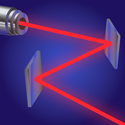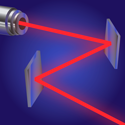Optical measurements in the dark
Electromagnetically induced transparency (EIT) is a two-photon process in which a laser turns an otherwise opaque material transparent to a probe field. The resonance frequency for EIT can be extremely narrow and the process can therefore be useful in making precision measurements of rotation (say, in a gyroscope) and for slowing down or storing light.
EIT experiments must know the distribution of atoms in the relevant energy levels and the rate at which their coherence decays. The linewidth of the two-photon transition can, in principle, reveal the coherence decay rate, but the true EIT linewidth is often masked by broadening mechanisms that are inherent to the laser. In a paper appearing in Physical Review A, Moshe Shuker and colleagues from the Technion-Israel Institute of Technology and the Weizmann Institute of Science demonstrate a method to probe both the population and the intrinsic coherence decay rate. First, strong laser pulses prepare the medium in a desired coherent superposition state. Then weak fields periodically probe the evolution of the various populations while the atoms are in the dark. The application of a small magnetic field causes oscillations in the probe signal whose decay time corresponds to the time it takes the atoms’ to lose coherence.
This work can be implemented in systems that use EIT, such as slow light or light storage, to experimentally measure the coherence rate and determine the efficiency of the process under study. – Frank Narducci





